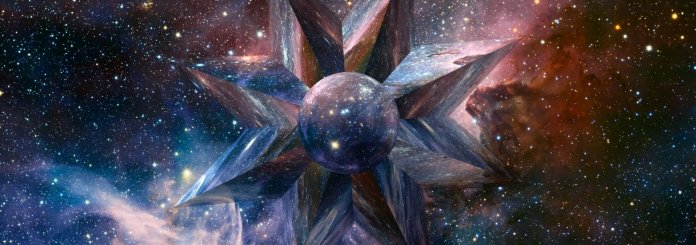Sacred Geometry Symbols – Ancient Meanings Depicted through Shapes and Figures

One of the many things that makes humanity unique on Earth is the ability to condense a deeply spiritual message or meaning into sacred geometry symbols. But what do the terms ‘sacred’ and ‘geometry’ really mean? We’re going to explore some of the sacred geometry meanings as we look through some of the most famous and powerful symbols, which despite dating back to ancient times are still used throughout the world today. We’ll consider the meaning of the flower of life, the power of a Metatron cube, and more. We’re starting off by considering the nature of geometry symbols.
What does sacred geometry mean?
In simple terms, geometry is a sub-section of mathematics. Within it, we use lines, dots, joined points, and more to create shapes. These become sacred when a deeper meaning is attached to these shapes or patterns.
Often, the shape itself simply represents a higher dimensional concept that can only be understood by converting it to a lower dimension, in this case, 2-D.
In a sense, this type of geometry allows us to represent complex ideas or thoughts through relatively simple shapes. We see examples of this in some of the oldest forms of art: cave painting.
Back before humans could read, write, or perhaps even communicate in a manner that could be described as a language, we were painting things on walls. We would often find naturally formed shapes within the rock and add new aspects to it.
Would you like to know who your Protective Guardian Angel is?
In order to get in contact with your Guardian Angel and receive your FREE ANGEL READING, please fill out this form:
From Merkaba symbol, from spirals to squares and to multiple circles with near-perfect symmetry, sacred geometry symbols can be found anywhere and everywhere. Sometimes we painted animals, humans, sometimes we painted a combination of the two, but sometimes we painted shapes, patterns, or seemingly random dots.
You can look to Ancient Egypt or modern-day Barcelona. You might explore a church or look around a contemporary art museum. No matter where you go, sacred geometry symbols will be there, in some form or another.
How many sacred geometry symbols and shapes are there?
The simple answer to this question is that there is potentially an infinite number of geometry shapes or symbols. Within any society, culture, civilization, religion, faith, institution, or anything else, sacred geometric shapes can be created or adapted. Any shape or symbol can take on a new meaning to new people.
The simplest way to gain a better understanding of geometry symbols is to explore some of them. We’re going to take a look at the Flower of Life symbol, the Metatron Cube symbol, and the Yan and Yang symbol.
What is the Flower of Life symbol?
As far as sacred geometry symbols go, the Flower of Life is arguably one of the most complex to draw and understand. It is said that this symbol represents a blueprint of all matter. It shows what was, what is, and what will be. It is the creation of the universe and expresses the moment of destruction.
The Flower of Life is said to represent every possible form and position a molecule can take, and through doing so it connects to all energy frequencies.
Within this shape, we find other common sacred geometry symbols such as the sunflower or snowflake. Both of these contain unique patterns, demonstrating the complex nature of this shape.
Unlike some other symbols, this one hasn’t been altered since its creation. We find examples of it through Ancient Egypt and Assyria. The Temple of Abydos in Egypt still displays examples of the Flower of Life and can be visited today.
What is a Metatron Cube?
A Metatron Cube is another example of the complex nature of certain sacred geometry symbols. It contains 13 circles (consisting of an outer-ring of 6, an inner-ring of 6, and a central circle), two hexagons, some rectangles, several triangles, and far too many lines to count. There are even some cubes and other shapes within the Metatron Cube, hence its name.
A Metatron Cube is said to contain a Flower of Life symbol. It is believed that through this shape, you can see all of the possible configurations that matter has taken, is taking, and will take. The Metatron Cube, above all else, represents creation.
Many people attribute this shape to the Judeo-Christian faiths, primarily Christianity and Judaism as the Archangel Metatron has become one of the 12 main Archangels. It is said that Metatron monitors and controls the flow of energy throughout the universe, and so his symbol acts as a steppingstone between humanity and the divine.
The Metatron Cube has connections to the tree of life, and in fact, it is said that both Metatron and Sandalphon held the tree of life at its base, and through doing so created a new symbol: the Metatron Cube.
Through it, energy could be channeled from all parts of the universe, bridging between the spiritual world and the material world, connecting mankind to God, and weaving the fabric of the universe into a deeply connected singularity.
What do Yin and Yang really mean?
When it comes to sacred geometry symbols, people often forget about some of the simpler examples. The Yin and Yang symbol dates back well into the depths of Chinese history and is believed to have been born within philosophy rather than spirituality or religion.
Many people attribute the shape of this symbol to observations of day and night, thus the Lunar cycles. During the day, the sun shines above us, a single point in the sky. Similarly, the moon does the same at night. But sometimes, you can see the moon in the sky, even when the sun is there, and is quite beautiful.
If we were to sum the Yin and Yang symbol up in one word, it would be balanced. Balance is the key to all things, and through balance we learn that there can be darkness within light, and there can be a light within the darkness.
This can be applied to the concepts of good and evil. A good person can still have moments of immorality, just as an immoral person can have moments of intense morality.
The symbol demonstrates that while we have two contrasting ideas, they are both essential to complete the circle, and in a sense, two halves are necessary to form a whole. Without light, there would be no dark, and without morality, there would be no immorality.

